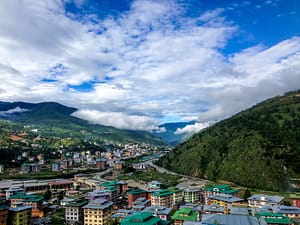PARKS
Jigme Dorji National Park & Hot Spring
The road along the MO Chhu valley leads north out of Punakha and enters Gasa Dzongkhag and Jigme Dorji National Park. Until recent times you had to trek much of this route, and though the road is steadily being improved, it remains a rough, slow drive. The rewards are the magical views, wonderful bird-watching, and the dzong. The hot springs, on the other hand, are primarily a destination for the sick and elderly seeking relief in the thermal waters.
Royal Manas National Park
After years of being off-limits due to security concerns this remote and enticing national park is now open to visitors. The park is little known, even among agents in Thimphu, and facilities are still limited: only 27 foreigners visited in 2011.
The park’s forests are home a wide variety of animals, including elephants, water buffalos, leopards, between 30 and 50 tigers, clouded leopards, civets, rhinoceros and 350 species of birds. The park abuts the Manas National Park in Indian Assam, forming a transnational conservation area.
Sakteng Wildlife Sanctuary
Set up in 2003, Sakteng Wildlife Sanctuary is the latest protected park to be set up in Bhutan. Measuring just 650 square kilometres, it harbours 35 of 46 species of rhododendrons as well as 203 tree species including herbs, shrubs, and small trees. Bird-watchers can keep a lookout for Assamese macaw, blood pheasant, grey backed shrike, grey headed woodpecker, common hoopoe, rufous vented tit and dark breasted rose finch.
Bumdeling Wildlife Sanctuary
Bumdeling Wildlife Sanctuary is located in northeast Bhutan, in the districts of Trashiyangtse, Lhuntshe, and Mongar. Created in 1994, the sanctuary covers 1,545 square kilometer, and is known for being the home of black-necked cranes in winter. Black-necked cranes also make Gangtey and Bumthang its home in winter. About 150 cranes stay in Bumdeling from mid-November to early March.
Jigme Singye Wangchuk National Park
Protecting the Black Mountains that separate eastern and western Bhutan, it harbours tigers, Himalayan black bears, red pandas and golden langurs. An amazing 450 species of bird have been catalogued.
Khaling Wildlife Sanctuary
In far southeastern Bhutan, the Khlaing Wildlife Sanctuary protects wild elephants, gaurs, leopards, pygmy hogs, hispid hares and other tropical wildlife. This sanctuary adjoins a comparable reserve in India
Phibsoo Wildlife sanctuary
On the southern border of Bhutan, it was established to protect the only remaining natural sal forest in Bhutan. Several protected species thrive here, including chital deer, elephants, gaurs, tigers, golden langurs and honrbills.
Tosa Strict Natura reserve
Torsa reserve is located where Torsa Chhu (river) enters from Tibet. The reserve was set aside to protect the temperate forests and alpine meadows and is the only protected area with no resident human population.
Thrumsing La National Park
This national park was set aside to protect old growth temperate forest of fir and chir pine. It is also home to red pandas and several endangered bird species including the rufous-necked hornbill and satyr trapogan pheasant
MUSEUMS
National Museum of Bhutan
Opened to the public in 1968, the National Museum of Bhutan in Ta Dzong at Paro has over 3000 artworks and masterpieces that display more than 1500 years of cultural heritage of Bhutan. These art works speak of various disciplines of arts and crafts in Bhutan and the various Bhutanese creative traditions. You can see an eclectic mix of past and present art forms here along with a glimpse of future of the Bhutan’s traditional arts. It is a must visit for all local and foreign visitors to Bhutan.
Folk Heritage Museum
Inaugurated by Her Majesty, the Queen Ashi Dorji Wangchuck on 28th July 2001, Phelchey Toenkhyim or the Folk Heritage Museum at Thimphu provides you a glimpse of lifestyle, items and artifacts of Bhutanese villages and rural households. Besides the display, the museum also organizes demonstrations of rural traditions, skills, habits and customs, educational programs for children and research and documentation on rural life of Bhutan. The museum building itself is one of the star exhibits of the library.
National Textile Museum
Her Majesty, the Queen Ashi Sangay Choden Wangchuck, inaugurated the National Textile Museum in 2001. She is also the patron of the museum and has helped in boosting both national and international interest in Bhutan’s textiles and textile art traditions. Bhutan’s textiles are an integral part of its cultural and heritage and are unique for their diversity and sophistication. Textile Museum at Thimphu has given a new platform to the nation’s textiles and Bhutanese weavers and boasts of an invaluable collection of antique textile artifacts of Bhutan.
MARKETS
Handicrafts Market
Across the Kundeyling Baazam cantilever footbridge from the Weekend Market, on the west bank, is this handicraft market, selling everything from wooden bowls and mala beads to printing blocks, amulets and yak tails. Bargaining is tolerated. Many items are made in neighbouring Nepal; your guide can advise you on the quality of your intended purchase.

